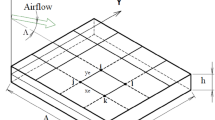Abstract
This work revisits the aero-elastic instability of a plate subjected to an axial subsonic flow and reports a refined numerical solution. The plate is fixed at its both ends, and the fluid computational region is decomposed into two subregions belonging to the plate area and the downstream outside area of the plate. Compared with the previous studies, the present numerical method is simple and straightforward, and is successfully extended to include the effect of the downstream outside area. By considering the downstream outside area, this problem is formulated as a boundary integral equation and three partial differential equations. Then the boundary integral equation is solved by the boundary element (BE) method, and the differential quadrature (DQ) method is applied for the partial differential equations. A wind tunnel experiment is completed for validations of the present fluid solution. Three cases of outside-area boundary conditions and four cases of plate boundary conditions are considered, and their influences on the plate instability behavior are studied. Results show that the present formulation is workable and is in good agreement with the existing theories. The effects of the outside area on the plate instability behavior, which have escaped the attention of the previous studies, are clearly observed. The present study can serve as references for other relative studies on plate instability.















Similar content being viewed by others
References
Watanabe Y, Isogai K, Suzuki S, Sugihara M (2002) A theoretical study of paper flutter. J Fluids Struct 16:543–560
Allen JJ, Smits AJ (2001) Energy harvesting eel. J Fluids Struct 15:629–640
Pineirua M, Doare O, Michelin S (2015) Influence and optimization of the electrodes position in a piezoelectric energy harvesting flag. J Sound Vib 346:200–215
Howell RM, Lucey AD (2015) Flutter of spring-mounted flexible plates in uniform flow. J Fluids Struct 59:370–393
Balint TS, Lucey AD (2005) Instability of a cantilevered flexible plate in viscous channel flow. J Fluids Struct 20(7):893–912
Cisonni J, Lucey AD, Elliott NS, Heil M (2017) The stability of a flexible cantilever in viscous channel flow. J Sound Vib 396:186–202
Sygulski R (2007) Stability of membrane in low subsonic flow. Int J Non-Linear Mech 42(1):196–202
Dowell EH (1975) Aeroelasticity of plates and shells. Noordhoff International Publishing, Leyden
Paidoussis MP (2004) Fluid-structure interactions. Slender structures and axial flow, vol 2, 1st edn. Elsevier Academic Press, London
Li P, Yang YR, Xu W, Chen G (2012) On the aeroelastic stability and bifurcation structure of subsonic nonlinear thin plates subjected to external excitation. Arch Appl Mech 82:1251–1267
Li P, Yang YR, Dong Y (2015) Bifurcation structure and scaling property of a subsonic periodically driven thin panel with geometric nonlinearity. ZAMM-App Math Mech 2:173–183
Li P, Yang YR, Zhang ML (2011) Melnikov’s method for chaos of a two-dimensional thin panel in subsonic flow with external excitation. Mech Res Commun 38:524–528
Li P, Yang YR (2011) Instability analysis of fluid and elastic panel system based on the differential quadrature method. In: Second International conference on mechanic automation and control engineering IEEE, pp 2258–2262
Li P, Yang YR, Xu W (2012) Nonlinear dynamics analysis of a two-dimensional thin panel with an external forcing in incompressible subsonic flow. Nonlinear Dyn 67:1251–1267
Li P, Yang YR, Shi HJ (2015) Hopf and two-multiple semi-stable limit cycle bifurcations of a restrained plate subjected to subsonic flow. J Sound Vib 335:286–303
Li P, Li ZW, Liu S, Yang YR (2018) Non-linear limit cycle flutter of a plate with Hertzian contact in axial flow. J Fluids Struct 81:131–160
Dugundji J, Dowell EH, Perkin B (1963) Subsonic flutter of panels on continuous elastic foundations. AIAA J 5:1146–1154
Ishii T (1965) Aeroelastic instabilities of simply supported panels in subsonic flow. Meeting of the AIAA, Los Angeles, AIAA Paper, pp 765–772
Burke MA, Lucey AD, Elliott NS, Howell RM (2013) Stability of a flexible wall separating two inviscid channel flow. In: Proceeding of the ASME 2013 Pressure Vessel and Piping Conference, 14–18 July 2013
Kornecki A, Dowell EH, O’Brien J (1974) On the aeroelastic instability of two-dimensional panels in uniform incompressible flow. J Sound Vib 47:163–178
Shahrokh K, Ellen CH (1979) The stability of partially rigid two-dimensional surfaces in uniform incompressible flow. J Sound Vib 65:339–351
Evetts RO, Howell RM, Lucey AD (2014) A new model for wake effects upon a cantilevered flexible plate undergoing continuous oscillation due to a high Reynolds-number axial flow. In: Proceedings of the 19th Australasian fluid mechanics conference, 8–11 December 2014
Howell RM, Lucey AD, Carpenter PW, Pitman MW (2009) Interaction between a cantilevered-free flexible plate and ideal flow. J Fluids Struct 25:544–566
Kwak MK (1996) Hydroelastic vibration of rectangular plates. ASME J Appl Mech 63:110–115
Katz J, Plotkin A (2001) Low-speed aerodynamics, 2nd edn. Cambridge University Press, New York
Bert CW, Malik M (1996) Differential quadrature method in computational mechanics: a review. Appl Mech Rev 49:1–27
Shu C (2000) Differential quadrature and its application in engineering. Springer, London
Peters DA (2008) Two-dimensional incompressible unsteady airfoil theory—an overview. J Fluids Struct 24:295–312
Acknowledgements
This work is supported by the National Natural Science Foundation of China (Grant Nos: 11302183; 11772273); and the Applied and Basic Research Plans of Sichuan Province, China (Grant No: 2015JY0083).
Author information
Authors and Affiliations
Corresponding author
Additional information
Publisher's Note
Springer Nature remains neutral with regard to jurisdictional claims in published maps and institutional affiliations.
Appendix
Appendix
The matrixes in Eq. (21) are:
The matrices in Eq. (22a,b) are:
Rights and permissions
About this article
Cite this article
Li, P., Liang, S., Zhang, D. et al. The instability of a plate fixed at both ends in an axial flow revisited: an application of the DQ–BE method. J Eng Math 118, 43–61 (2019). https://doi.org/10.1007/s10665-019-10013-x
Received:
Accepted:
Published:
Issue Date:
DOI: https://doi.org/10.1007/s10665-019-10013-x




